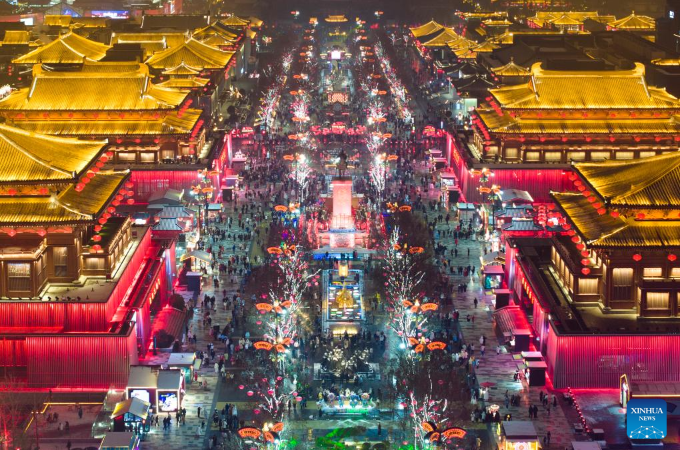China's lakes become bluer, greener: study
Source: Xinhua | 2023-05-09 | Editor:Christine

This aerial photo taken on April 17, 2023 shows a view of the Basum Lake in Gongbo'gyamda County of Nyingchi, southwest China's Tibet Autonomous Region. (Xinhua/Sun Fei)
Chinese scientists and their international counterparts have recently discovered that China's lakes have become bluer and greener in recent decades because of reasons that include higher temperatures and rainfall.
Optically active substances in lake water can interact with sunlight, such as light absorption and scattering, making lakes show different colors. Previous studies have mapped the variations in lake colors in China, but their changing patterns and relevant reasons over the past decades remain unclear.
Researchers from Nanjing Institute of Geography and Limnology under the Chinese Academy of Sciences and other institutions in China, as well as those from the United States and Estonia, used satellite images to track annual trends of colors of more than 2,500 lakes in China since the 1980s.
According to the study published recently in the journal Geophysical Research Letters, the colors for 68 percent of the lakes from 1984 to 2021 shifted toward shorter visual wavelengths. The blue lakes in western China, such as the Qinghai-Tibet Plateau, became bluer, while the green-yellow lakes in eastern China shifted to greener colors.
The researchers also revealed the reasons behind such color changes. Most of the lakes on the Qinghai-Tibet Plateau are deep, and their water colors are mainly blue. Their colors turning bluer in the past 40 years are mainly related to lake expansion and increased transparency caused by climate warming and humidification.
In eastern China, lakes are mainly shallow and their colors are green or yellow. The decrease in wind speed in most areas in the past 40 years has weakened the sediment resuspension, while the increase of vegetation in the basin reduces the particulate matter entering the lake. They both have made the lakes turn greener.
The findings can help to understand the changes in lake colors and their responses to climate change and human activities, according to the study.
You May Like
-
China Focus: AI technology invigorates China's digital devel...
At the 6th Digital China Summit, an exhibitor surnamed Zhang experienced an AI emotion-recognition system. Simply standing in front of the device, her stress va...
InKunming 2023-04-29 -
GLOBALink | Digital tech plays role in protecting Gansu Grea...
Authorities in northwest China's Gansu Province recently completed the building of a three-dimensional database to digitally map the Great Wall in order to ensu...
InKunming 2023-04-29 -
Xinhua Commentary: Major powers should work with China for p...
Chinese President Xi Jinping on Wednesday held phone talks with his Ukrainian counterpart, Volodymyr Zelensky.
InKunming 2023-04-28 -
Luban Workshop: a bridge of cultural, people-to-people commu...
Lu Ban is an ancient Chinese woodcraft master who represents the Chinese tradition and spirit of craftsmanship.
InKunming 2023-04-28 -
China's ports to handle 1.2 million entries, exits daily dur...
China will see a daily average of 1.2 million arrivals and departures at its ports during the upcoming May Day holiday, doubling the figure from last year, the ...
InKunming 2023-04-28 -
China Focus: China's digital economy a new growth engine to ...
China's digital economy, ranking second in the world for many years, has seen robust growth and become a major growth engine for the country marching toward mod...
InKunming 2023-04-28 -
China holds summit to boost digital development
The 6th Digital China Summit opened on Thursday in the city of Fuzhou in east China's Fujian Province.
InKunming 2023-04-28 -
China expects 120 mln railway trips around May Day
About 120 million domestic trips are expected to be made by Chinese railway passengers from April 27 to May 4 around the May Day holiday, said the China State...
InKunming 2023-04-28 -
Xinhua Headlines: China leads trends of global auto industry
The 20th Shanghai International Automobile Industry Exhibition concluded on Thursday at the National Exhibition and Convention Center (Shanghai), where approx...
InKunming 2023-04-28 -
Women innovators shine with IP progress
China's remarkable progress in independent innovation has been characterized by the growing participation of women in the intellectual property (IP) industry.
InKunming 2023-04-27







